Almost two years ago, I began a four-round tournament using all 144 players in the APBA All-Time Greats (ATG) card set. During this past week’s hiatus, I finished round 2 at Badger Links with Jack Nicklaus (1975) atop the leaderboard at -10. Round 1 at Yatch Club was completed in the spring of 2021 with Lee Trevino (1971) at 8 under, leading Jim Furyk (2003) and Nicklaus by two strokes.
Among Round 2’s biggest surprises was Roberto De Vicenzo who shot a round-best 65 (-7), moving up 71 spots from a tie for 80th place to a tie for 9th. Other big gainers in the Top 10 were Sam Snead (1941) and Gene Sarazen (1930), who moved up 34 and 16 spots respectively to also claim a share of 9th place.
Here’s the top portion of the leaderboard, showing how the current leaders shot in Round 2 (R2 Rank) compared to Round 1 (R1 Rank).
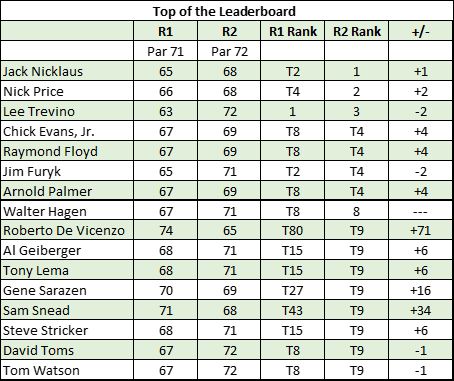
For perspective, here is a table showing the Biggest Gainers overall, in other words, those who advanced the most up the leaderboard from Round 1 to Round 2.
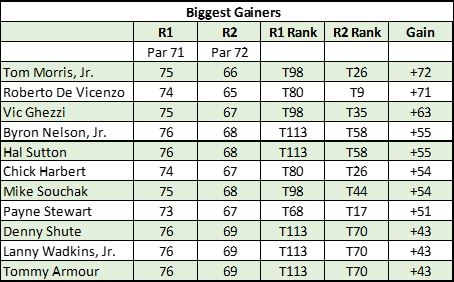
Young Tom Morris (1870) made the biggest leap (+72), moving from a tie for 98th place to a tie for 26th. He did this mainly by putting “lights out,” sinking 23 putts for a total distance of putts made of 190 feet! He is followed closely by De Vincenzo, who I previously mentioned jumped +71 in the rankings to finish Round 2 in the Top 10.
The Biggest Losers–those who dropped the most on the leaderboard–include some World Golf Hall of Famers, such as Bobby Jones, Jr. (1930) and Mark O’Meara (1998), who dipped 56 and 66 spots, respectively. But no one fell as far as Willie Park, Jr. (1889) who dropped from a tie for 21st place to a tie for 118th (-97). Poor Willie with an 81 (+9) had trouble hitting fairways (42.9%), greens (44.4%), and the hole (33 putts).
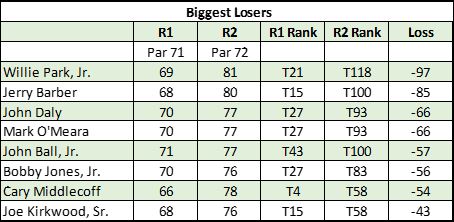
Although Trevino and Furyk drove the ball reasonably well at Badger Links and Furyk hit an impressive 15 greens in regulation, neither player putted their best. Trevino had 30 putts for a Total Distance of Putts Made of 70 feet; Furyk had 33 putts for a mere 49 feet. Meanwhile, Nicklaus took only 26 putts and drained them from a distance totaling 124 feet.
While the entire group averaged 29.2 putts per round, two full strokes more than at Yatch Club, De Vincenzo had the fewest putts (21) in Round 2. This is 9 strokes fewer than he had in Round 1 (30).
Here is a table showing the golfers whose number of putts decreased the most between rounds.
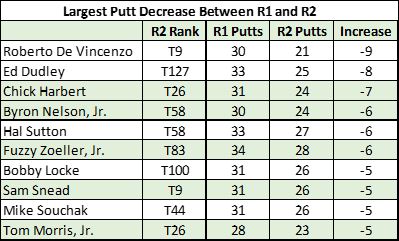
Some of the largest decreases in putts between Rounds 1 and 2 are probably attributable to regression to the mean. Of those that shaved off 5 or more putts, only one player (Young Tom Morris) had under 30 putts in the first round.
Then there were those who went in the opposite direction.
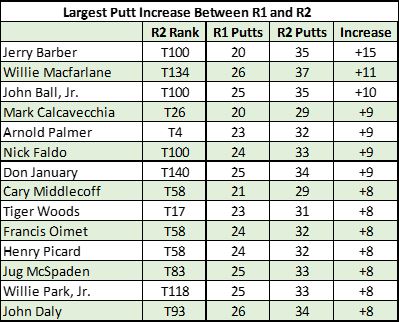
Jerry Barber (1961) tops that list, going from a round-low of 20 putts on the tiny greens at Yatch Club to 35 on the more spacious putting surfaces of Badger Links. The worst putting performance was turned in by Willie Macfarlane (1925) who managed 37 putts for a Total Distance of Putts Made of only 41 feet. That was the second worst increase in putts between rounds (+11). Note that none of these golfers had more than 26 putts in Round 1. Regression operates in both directions, you know.
Overall, players shot an average score of 72.3 on Badger Links (Par 72). While that’s only 0.3 strokes better than the first round, Yatch Club is a Par 71. Here’s a tournament summary, showing both rounds.
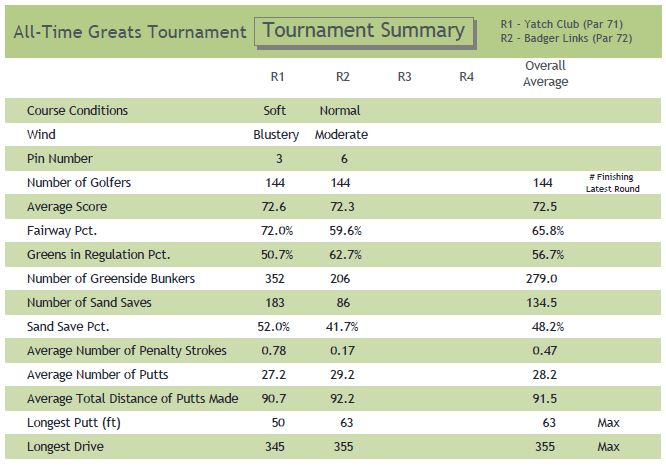
Badger Links is a challenging course due to vast acreage of deep rough and fairway bunkers. Mercifully, unlike the actual course (Whistling Straits), Badger Links does not have any deep bunkers. It does have some wicked pin placements, though, and I had the misfortune of drawing one of them (#6) on my die roll at the beginning of the round.
That said, there were some duplicate (and missing) hole numbers on my APBA course boards that necessitated editing pin locations on a couple of holes. Here’s an example of one of the tougher pin locations for this round: Hole #3, a 183-yard Par 3.
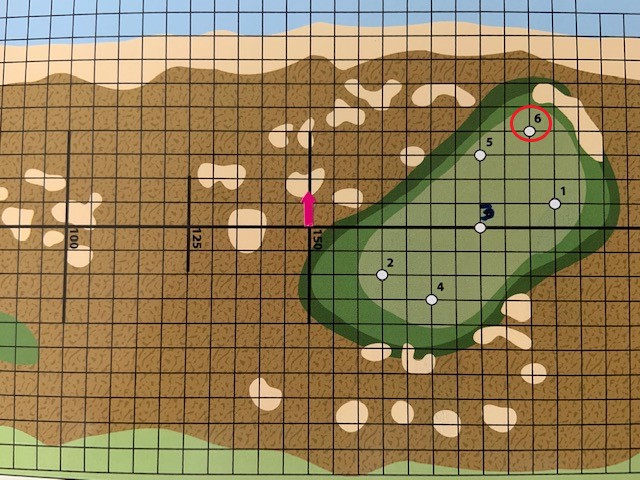
Note that the pin location is 20 yards off the centerline (CL), which means working-the-ball (WTB) to have any chance of getting a birdie. Yet, the hole note dictates that any ball landing in the fairway or rough left of the CL and beyond the 150-yard mark, pitches left 10 yards. Go too far left and you end up short-sided far from the CL or in Lake Michigan.
Not surprisingly, hole #3 was one of the two most difficult on the course, averaging 0.34 strokes over par. The other was hole #18, a 489-yard Par 4 (+0.35). It also had a devilish pin location, 20 yards off the CL and guarded in front by water and bunkers.
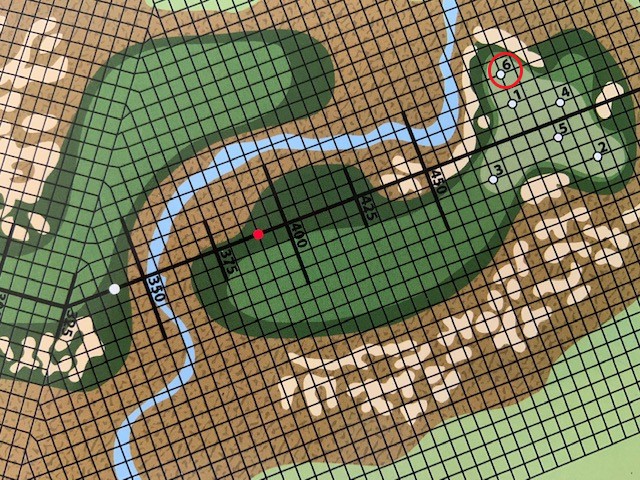
The easiest hole by far was the relatively short hole #16, a 535-yard Par 5. With 15 eagles and 57 birdies, it played 0.56 strokes below par. No one shot worse than a 6 on this hole.
There was only one ace this round. Ted Ray (1913) somehow managed to find the hole with his tee shot on #12, a 180-yard Par 3 with another wicked pin placement.
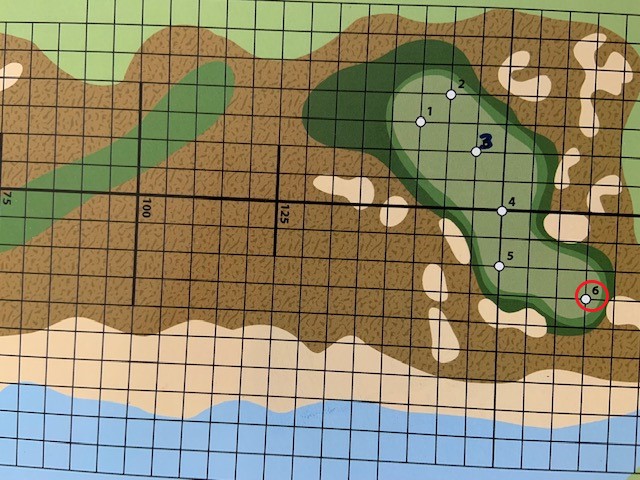
Unfortunately, Ray’s 70 (-2) wasn’t enough to help him make the cut. He finished his two rounds at +2, and the cut line was set at +1. In all, 69 players will move on to Round 3, which is set to be played at Gopher Lakes as the tour winds its way westward.
For a complete look at all the stats from this tournament, click on the PDF viewer below.